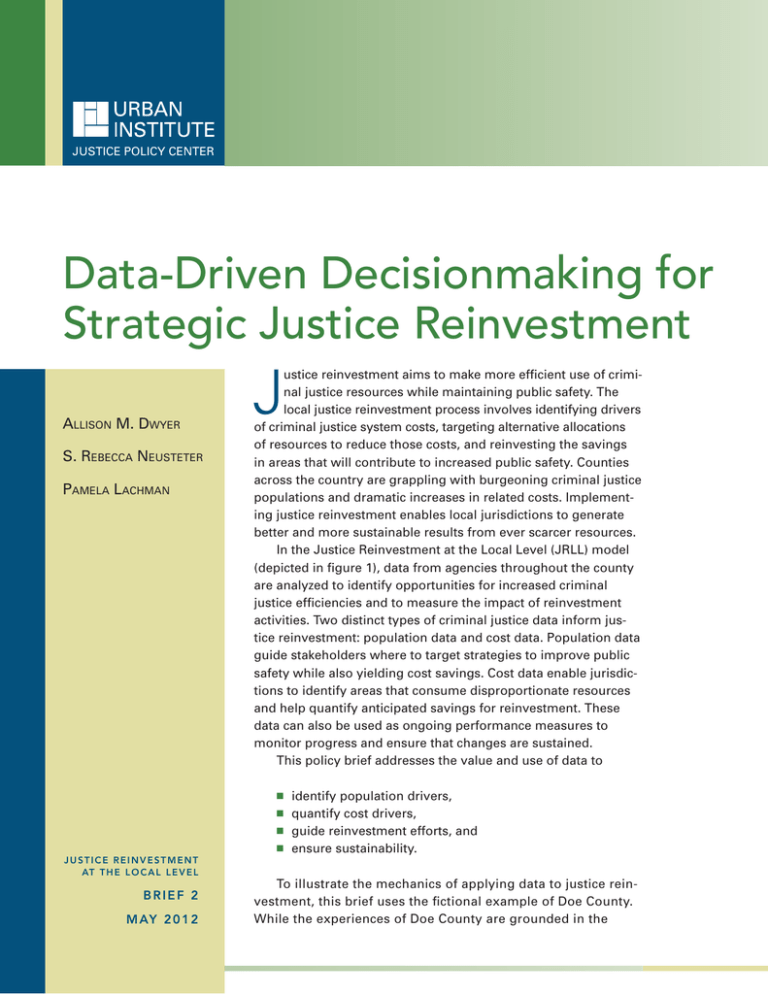J Data-Driven Decisionmaking for Strategic Justice Reinvestment 1
advertisement

Data-Driven Decisionmaking for Strategic Justice Reinvestment 1 Justice Policy Center Data-Driven Decisionmaking for Strategic Justice Reinvestment Allison M. Dwyer S. Rebecca Neusteter Pamela Lachman Justice Reinvestment at t h e L o c a l L e v e l Brief 2 MAy 2 0 1 2 J ustice reinvestment aims to make more efficient use of criminal justice resources while maintaining public safety. The local justice reinvestment process involves identifying drivers of criminal justice system costs, targeting alternative allocations of resources to reduce those costs, and reinvesting the savings in areas that will contribute to increased public safety. Counties across the country are grappling with burgeoning criminal justice populations and dramatic increases in related costs. Implementing justice reinvestment enables local jurisdictions to generate better and more sustainable results from ever scarcer resources. In the Justice Reinvestment at the Local Level (JRLL) model (depicted in figure 1), data from agencies throughout the county are analyzed to identify opportunities for increased criminal justice efficiencies and to measure the impact of reinvestment activities. Two distinct types of criminal justice data inform justice reinvestment: population data and cost data. Population data guide stakeholders where to target strategies to improve public safety while also yielding cost savings. Cost data enable jurisdictions to identify areas that consume disproportionate resources and help quantify anticipated savings for reinvestment. These data can also be used as ongoing performance measures to monitor progress and ensure that changes are sustained. This policy brief addresses the value and use of data to 77 77 77 77 identify population drivers, quantify cost drivers, guide reinvestment efforts, and ensure sustainability. To illustrate the mechanics of applying data to justice reinvestment, this brief uses the fictional example of Doe County. While the experiences of Doe County are grounded in the 2 Data-Driven Decisionmaking for Strategic Justice Reinvestment Figure 1. Local Justice Reinvestment Model STEP 1 Collect and Analyze Criminal Justice Data STEP 5 Implement and Assess Justice Reinvestment Strategies Interagency Strategic Planning STEP 4 Document Savings and Public Safety Impact STEP 2 Identify Cost-Saving Public Safety Strategies STEP 3 Implement Cost-Saving Public Safety Strategies INCREASED PUBLIC SAFETY AND REDUCED COST implementation experiences of real counties and provide realistic depictions of the process, all numbers and examples are fictional and should not be attributed to any specific site. Locating and Accessing Data As the central point on the justice reinvestment model indicates (see figure 1), the key to successful implementation is interagency strategic planning.1 Once an active collaborative body is in place, the next step is to collect and analyze data to inform the development and implementation of more cost-beneficial interventions. Data used to inform a reinvestment strategy and measure its impact must come from agencies across the locality and criminal justice system. For example, it is nearly impossible to understand why the jail population fluctuates without examining data from the courts, arresting agencies, the jail, and other relevant local agencies. The necessary data may already be collected in the county or may be generated using existing data systems. It is possible, however, that desired data may not be accessible retrospectively and can only be collected moving forward. Table 1 details the data various agencies may be able to provide in order to identify cost and population drivers in the county. Note, however, that these agencies may have limited experience coordinating data sharing and may have incompatible data management programs, different definitions of key elements, and disparate standards for sharing data.2 Identifying Population Drivers The first two phases of the justice reinvestment model involve using data to identify areas where efficiencies can generate savings. While justice reinvestment requires stakeholders to examine costs across the system, the largest cost-efficiency improvements can often be identified by reviewing how populations flow through the local jail. Although jails typically represent a major financial cost to the local criminal justice system, other agencies’ decisions impact jail populations. Identifying how populations move through the local criminal justice system, with an eye toward targeting drivers of jail costs, can illustrate where improved efficiencies may be found. To identify drivers, stakeholders might begin by asking the following questions of the criminal justice system (or refer to the Getting Started worksheet “Moving Data Collection Forward” at the end of this brief): 77 Which individuals flow through the following system stages: jails, courts, alternatives/diversions, and probation/parole? 77 What factors (such as charges) influence their movement through the system? 77 For how long are these individuals in the system (what is their average length of stay at each point)? Data-Driven Decisionmaking for Strategic Justice Reinvestment Table 1. Potential Data for Intervention Points Intervention point Data information intervention point Associated agency costs System entry n Arrest/citation information n Booking information n Demographics n Charges n Risk/needs information n Arresting agency costs (including overtime) n Jail costs (including overtime) n Court costs (calendaring, bail hearings, court staffing) n Prosecutor costs n Defense attorney costs Pretrial n Pretrial release method n Pretrial release information (employment, priors, etc.) n Indigency procedures n Release eligibility n Type of release n Pretrial diversion or alternative programs (drug court) n Pretrial diversion operating costs n Specialized docket costs n Community supervision costs n Release condition costs Case processing n Length of stay in detention facility n Case processing disruptions (resets, continuances, failures to appear, etc.) n Case processing time (time from arrest or arraignment to case disposition) n Court administration costs n Prosecutor costs n Defense attorney costs n Jail costs Sentencing n Use of alternatives to jail (e.g., community supervision, diversion programs, treatment programs etc.) n Sentence length n Sentence type n Postrelease supervision n Court administration costs n Alternative program costs n Jail costs Reentry n Volume of repeat bookings, arrests, and convictions n Characteristics (type of charge, previous release, sentence, etc.) of recidivist population n Reentry service provider costs n Costs from agencies involved in incarceration and case processing n Costs associated with the recidivist population (disproportionate resources used across wide variety of agencies) 77 How do they exit the criminal justice system? 77 Who returns and why? In answering these fundamental questions, stakeholders can identify opportunities for strategic changes that can both significantly reduce criminal justice costs and meaningfully enhance public safety. For example, a review of Doe County’s data revealed that over 70 percent of jail detainees were being held on a pretrial status. This figure is nearly 10 percent higher than the average for U.S. jails (Minton 2011), which highlighted the pretrial population in Doe County as a potential population driver meriting further review. To determine why this population is high, stakeholders examined additional characteristics, including charges, demographics, and characteristics representing risk (e.g., criminal justice history) and needs (e.g., chronic homelessness), as well as the movement of their cases through the system. The Doe County data analysis also demonstrated that although the bulk of the pretrial population was able to post bail, the process took an average of seven days from booking to release. This finding suggests that jail bed consumption for the population of pretrial detainees 3 4 Data-Driven Decisionmaking for Strategic Justice Reinvestment is more likely caused by processing delays and challenges in posting bond, rather than court decisions to deny bail. Thus, there is likely an opportunity to expedite bail procedures, a change that could save money by reducing the jail space required for this population without altering existing release policies or court decisions. This population’s imminent release also suggests that expediting bail procedures would have little impact on public safety. The next step was for Doe County to examine whether case processing or bail policies could be changed to expedite progression through the system and then to assess whether such changes would yield cost savings or affect public safety. Indeed, public safety must be at the forefront when considering modifications to current criminal justice operations. The justice reinvestment model would enhance public safety by allocating resources more cost effectively, rather than cutting expenses to the detriment of public safety. Stakeholders should seek out data-supported interventions that both enhance safety and reduce costs. Quantifying Cost Drivers Not all drivers have equal costs, and collecting data can help jurisdictions quantify the costs of current criminal justice practices objectively and responsibly; doing so enables the identification of changes to policies and practices that will yield the greatest possible savings. To begin quantifying costs, it is important to start with a common language that ensures the concerns of stakeholders are adequately addressed. As the jail is often a large cost, it is valuable to quantify how expensive, on average, it is for the county to keep an individual in jail. The most basic calculation of this figure is called a jail bed day (JBD) and can be determined by using the equation below. average length of stay 3 number of admissions 5 jail bed days consumed Jail bed days are valuable for demonstrating the relationships among admissions, length of stay, and the relative costs to the system of different populations within the jail.3 This calculation cannot be used, however, to quantify savings reliably due to the marginal costs associated with operating a detention facility. The formula is best used to compare the resource consumption of different populations, such as unsentenced misdemeanants and unsentenced felons, and is valuable in demonstrating how changes in jail bed day consumption impact the average daily population (ADP). Through this comparison, policymakers can target groups that consume the largest share of resources rather than relying solely on the number of admissions. As the formula suggests, a few individuals who stay in the jail for a long period of time can, and often do, consume more resources (in the form of jail bed days) than a large number of individuals who remain in the jail for a short period of time. However, actual costs of the jail facility are based primarily on unit costs rather than per capita costs. For example, a facility may need a reduction of 30 jail bed days, sustained over a year, before costs can be reduced by closing a dormitory or reducing a food contract. While closing a jail facility is unrealistic for many counties, unit reductions such as closing a housing unit or eliminating a duty post can significantly alleviate costs. Such a shift can also mitigate the need to build a new facility, an option that should be viewed as the last possible strategy for reducing pressures on existing jail capacity. The example of Doe County below aims to illuminate how calculations and data can inform JRLL efforts. Examining budget data and operating costs can help stakeholders determine the most cost effective options while maintaining public safety. To quantify these options, data should be collected on populations served, costs per person and per unit, capacity, and enrollment for each potential outcome (jail, Data-Driven Decisionmaking for Strategic Justice Reinvestment 5 Strategizing with Data Example 1 Assume that over the period examined, the Doe County jail has an ADP of 1,000 people; they have noted that over 70 percent of their population had not been adjudicated. County stakeholders decide to examine how to process this pretrial population more efficiently. In a representative month, the jail reports that 400 people with felony charges were released on bail, posting in an average of 10 days, and 500 people with misdemeanor charges were released on bail, posting in an average 7 days. The JBD formula indicates that people who eventually posted bail consumed 7,500 jail bed days in one month (4,000 from felony charges, 3,500 from misdemeanor charges). If the time taken for this group to post bond could be reduced to felonies posting in 5 days and misdemeanors posting in 3 days, the group would consume just 3,500 JBDs monthly, a net reduction of 4,000 JBDs per month. Speeding up the bail process for those who will eventually post bail, an option that requires neither releasing more nor booking fewer individuals, is the equivalent of reducing the ADP for this population by 11 people per month, or just under half of a 30-bed dormitory. Doe County previously only allowed bail to be posted in person at the jail from 7:00 a.m. through 9:00 p.m. Monday through Friday. Enacting a simple change in how bail is accepted, by allowing people to post bail by telephone or online, accomplished this goal by decreasing the average amount of time to post bail. Used in conjunction with other interventions, this approach could enable Doe County Jail to close a dormitory. Example 2 Data from Doe County also indicated that about 35 percent of the population had been booked into the county jail multiple times within one year. However, in examining the number of individuals and the aggregate length of time they spent in the jail facility, stakeholders discovered that this 35 percent of the population was consuming nearly 70 percent of the facility’s JBD resources. Stakeholders then focused data collection on that 35 percent, who were returning detainees, to determine the population’s characteristics and reasons for jail return. The answers helped leaders determine which strategies could maximize cost savings and enhance public safety. In Doe County, this “frequent user” population was determined to be largely homeless; therefore, stakeholders developed interventions to provide supportive housing with the help of local community agencies. If the population were composed largely of chronic inebriates or those with mental illnesses, alternatives such as expanded inpatient care might prove beneficial. probation, alternatives/diversion programs, bail types, etc.) and on recidivism rates (ideally by population type). Directing Reinvestment Efforts Once population and cost drivers have been identified, data can inform the best approach to addressing each driver. Anticipated cost savings, reinvestment strategies, and sustainability plans can be projected to enable stakeholders to make informed decisions. Such projections should include 77 real estimates of how much the population must decline to achieve significant cost savings, 77 projected cost reductions based on county experiences and studies of similar programs, and 77 the timeline for reinvestment implementation. Engaging in such data-driven planning enables stakeholders to assemble formal or informal agreements about how generated savings will be reinvested (see worksheet). Savings frequently come in averted spending (e.g., reduced population precludes the need to construct additional space or hire additional staff), rather than a reduction in the current operating budget. More significant savings may be realized over several years. Therefore, modeling the system impacts and grounding 6 Data-Driven Decisionmaking for Strategic Justice Reinvestment these projections in data is crucial to developing a successful reinvestment strategy and achieving collaboration at the reinvestment stage. Ensuring Sustainability Data are integral to sustaining the iterative process of justice reinvestment by facilitating collaboration, providing feedback on intervention strategies, and informing future efforts. Performance indicators can be used to monitor progress throughout the JRLL process, to identify potential shifts early enough to implement interventions, and to continue to justify and target reinvestment spending. Performance measures are generally divided into two categories: internal and external. Internal measures, such as evaluating the size of the jail population or program enrollment, are typically objective quantitative data and enable stakeholders to monitor changes within the system and measure successes over time. External measures, such as the degree of interagency collaboration, provide stakeholders with information to assess the context of information related to the local criminal justice system policies and fiscal impact (Allen 2010). Table 2 shows some internal and external performance measures relevant to monitoring the jail population. By monitoring these measures, the jurisdiction can accurately quantify and assess the state of the criminal justice system, identify significant deviations from expected norms, and plan activities accordingly (CCAP and Temple University 2005). For example, if a rapid spike in violent crime is experienced, an increase in the jail population can be anticipated. With this information, law enforcement and jail staff can prepare to accommodate fluctuations in the jail population as cost effectively as possible without compromising public safety. If internal and external factors are not consistently monitored, they may turn foreseeable challenges into unforeseen crises. Additional Resources Justice Reinvestment at the Local Level Brief Series: Tracking Costs and Savings through Justice Reinvestment, http://www.urban. org/url.cfm?ID=412541. Justice Reinvestment at the Local Level Brief Series: Improving Strategic Planning through Collaborative Bodies. http://www. urban.org/url.cfm?ID=412543. Justice Reinvestment at the Local Level Planning and Implementation Guide. http:// www.urban.org/url.cfm?ID=412233. Table 2. Performance Measures Internal performance measures External performance measures n Number and type of arrests n Fear of crime n Number of bookings into jail n Perceptions of community quality of life n Size of the jail detainee population n Speed of case processing n Number of detainees eligible and released on bond by offense type n Use of bail policies n Number of detainees eligible and released on recognizance (personal bond) by offense type n Confidence in the use of criminal justice fiscal resources n Number of dispositions n Time between case processing events n Enrollment in and completions of programs n Number of individuals on parole/probation n Number and type of technical violations n Perceptions of personnel efficiency Data-Driven Decisionmaking for Strategic Justice Reinvestment Notes 1. For more information, see the companion brief by Archer, Neusteter, and Lachman (2012). 2. More information on overcoming data challenges is available in La Vigne et al. (2010). 3. For a detailed explanation of the relationship between length of stay, number of bookings, and jail population fluctuations, see Cushman (2002). 4. More detailed information on developing a reinvestment strategy is available in the companion brief by Lachman and Neusteter (2012). References Allen, Jennifer M. 2010. Administration and Management in Criminal Justice: A Service Quality Approach. Los Angeles, CA: Sage Publishing. Archer, Justin, S. Rebecca Neusteter, and Pamela Lachman. 2012. “Improving Strategic Planning through Collaborative Bodies.” Justice Reinvestment at the Local Level brief 3. Washington, DC: The Urban Institute. http:// www.urban.org/url.cfm?ID=412543. County Commissioners Association of Pennsylvania (CCAP) and Temple University Department of Criminal Justice. 2005. “Exploring Problems and Prospects for Controlling County Jail Populations in the United States.” Washington, DC: U.S. Department of Justice, National Institute of Justice. Cushman, Robert. 2002. “Preventing Jail Crowding: A Practical Guide.” Washington, DC: National Institute of Corrections. http://nicic. gov/pubs/2001/016720.pdf. La Vigne, Nancy G., S. Rebecca Neusteter, Pamela Lachman, Allison Dwyer, and Carey Anne Nadeau. 2010. Justice Reinvestment at the Local Level: Planning and Implementation Guide. Washington, DC: The Urban Institute. http://www.urban.org/url.cfm?ID=412233. Lachman, Pamela, and S. Rebecca Neusteter. 2012. “Tracking Costs and Savings through Justice Reinvestment.” Justice Reinvestment at the Local Level brief 1. Washington, DC: The Urban Institute. http://www.urban.org/ url.cfm?ID=412541 . Minton, Todd. 2011. “Jail Inmates at Midyear 2010—Statistical Tables.” Washington, DC: Bureau of Justice Statistics. http://bjs.ojp. usdoj.gov/index.cfm?ty=pbdetail&iid=2375 (accessed March 7, 2012). Copyright © May 2012 The views expressed are those of the authors and do not necessarily reflect those of the Urban Institute, its partners, its trustees, or its funders. Permission is granted for reproduction of this document, with attribution to the Urban Institute. 7 8 Data-Driven Decisionmaking for Strategic Justice Reinvestment Getting Started Worksheet: Moving Data Collection Forward To use data to inform local justice reinvestment efforts, the first step is to convene stakeholdersa to discuss what information is available. The following set of questions can help jurisdictions develop individual data approaches: 1. What agencies are involved in the criminal justice system and how do they approach data now? What agencies are involved in the criminal justice system? Are data compatible with other agencies? Do memorandums of agreement exist to enable data sharing? Is there a common identifier to link data files? Yes No Yes No Yes No Yes No Yes No Yes No Yes No Yes No Yes No Yes No Yes No Yes No Yes No Yes No Yes No Yes No Yes No Yes No Yes No Yes No Yes No What data are collected on the jail population? What data could be collected in the future? Which agency has these data? 2. What alternatives/programs have been implemented already, and what is currently working? What alternatives/programs have been implemented already? Is there enough capacity for demand? Has this program been evaluated? Yes No Yes No Yes No Yes No Yes No Yes No Yes No Yes No Yes No Yes No Yes No Yes No Yes No Yes No What impact has this program had on crime or recidivism? 3. What costs are associated with different criminal justice outcomes? a. Read more about stakeholder engagement in the companion brief “Improving Strategic Planning through Collaborative Bodies” (Justin Archer, S. Rebecca Neusteter, and Pamela Lachman, Justice Reinvestment at the Local Level brief 3. Washington, DC: The Urban Institute, 2012. http://www.urban.org/url.cfm?ID=412543.) Data-Driven Decisionmaking for Strategic Justice Reinvestment CJ outcome Annual costs Costs per person Incarceration $ $ Probation $ $ Substance abuse diversion $ $ Mental health diversion $ $ Other $ $ Other $ $ Agency/ies involved Populations served 9 Are any populations particularly costly? 4. What is driving the jail population? Consider unsentenced population (court processing, bail issues), sentenced population (transfers to prison, length of sentence), frequent users (those who are homeless, chronically inebriant, and/or have mental health conditions or co-occurring disorders). 5. What data would convince stakeholders to commit to reinvestment strategies? Where would savings accrue? What agency budgets would be impacted? 6. How are data being used to measure success and ensure the long-term sustainability of effective programs/ initiatives? 10 Data-Driven Decisionmaking for Strategic Justice Reinvestment The Justice Reinvestment Initiative In October 2010, the Bureau of Justice Assistance formalized the Justice Reinvestment Initiative (JRI) to expand prior state and local justice reinvestment work. JRI provides technical assistance and competitive financial support to states, counties, cities, and tribal authorities either currently engaged in justice reinvestment or well positioned to undertake such work. The initiative is structured in two phases: in Phase I sites receive intensive onsite technical assistance to start the justice reinvestment process and in Phase II sites receive targeted technical assistance and are eligible for seed funding to support the implementation of justice reinvestment strategies. For more information about JRI, visit http://www.bja.gov/JRI. Justice Reinvestment at the Local Level (JRLL) was a partnership between the Urban Institute and three local jurisdictions: Alachua County, Florida; Allegheny County, Pennsylvania; and Travis County, Texas. For more information on JRLL, e-mail jrll@urban.org or visit us online at http://justicereinvestment.urban.org. This project was supported by Grant No. 2009-DD-BX-K040 awarded by the Bureau of Justice Assistance. The Bureau of Justice Assistance is a component of the Office of Justice Programs, which also includes the Bureau of Justice Statistics, the National Institute of Justice, the Office of Juvenile Justice and Delinquency Prevention, the Office for Victims of Crime, and the Office of Sex Offender Sentencing, Monitoring, Apprehending, Registering, and Tracking. Points of view or opinions in this document are those of the author and do not necessarily represent the official position or policies of the U.S. Department of Justice.






